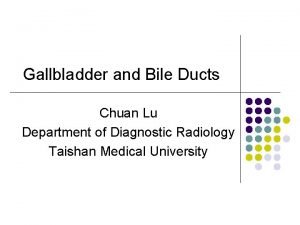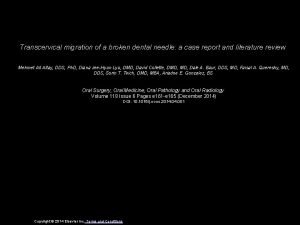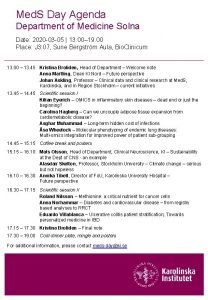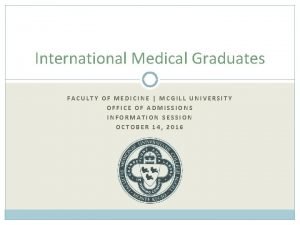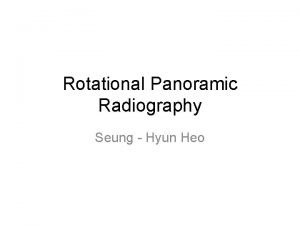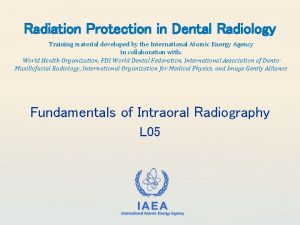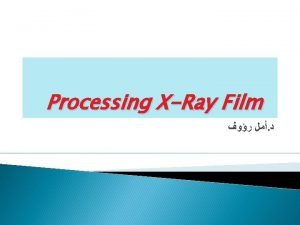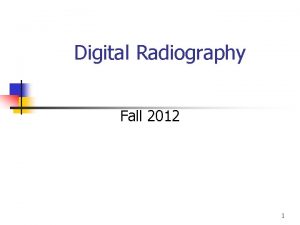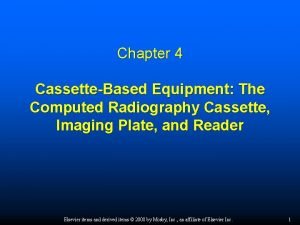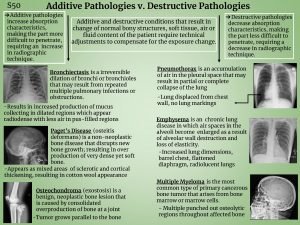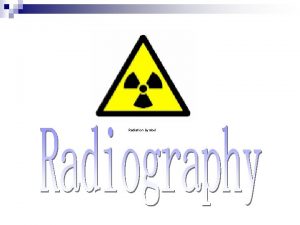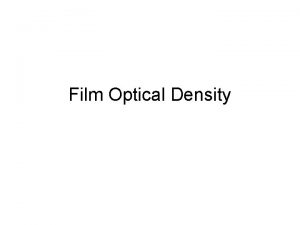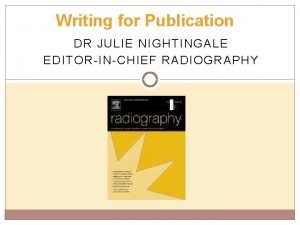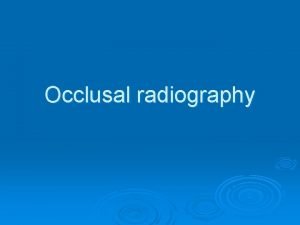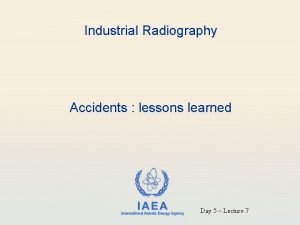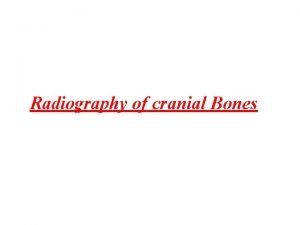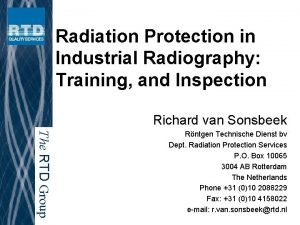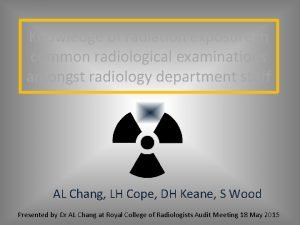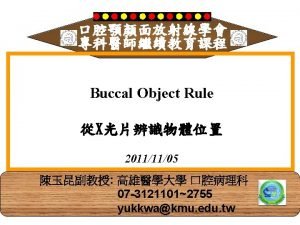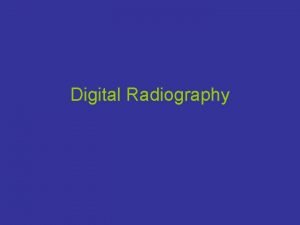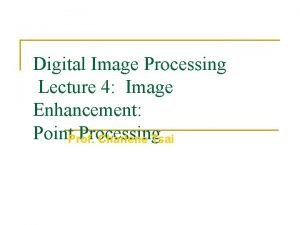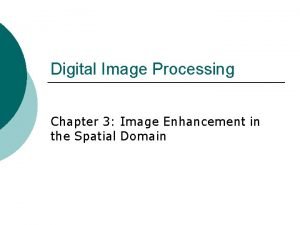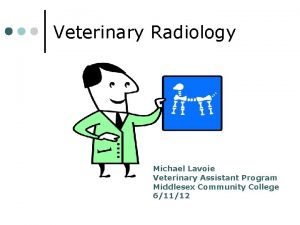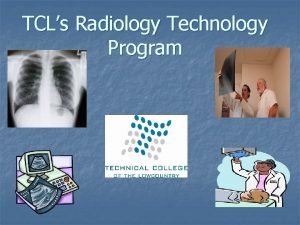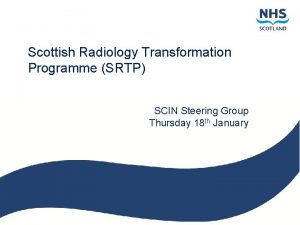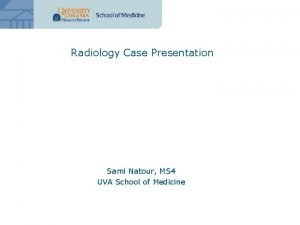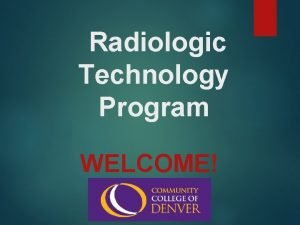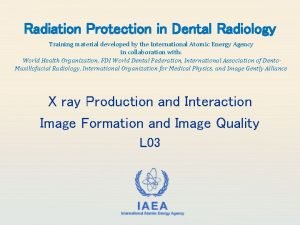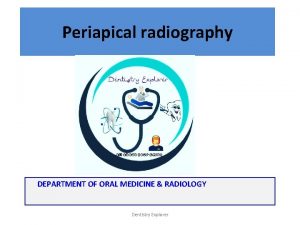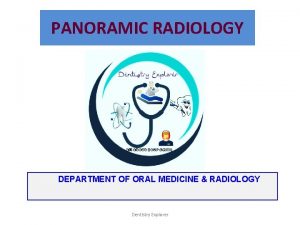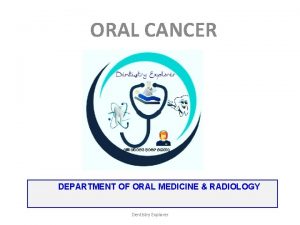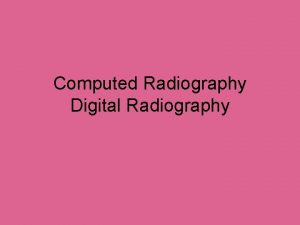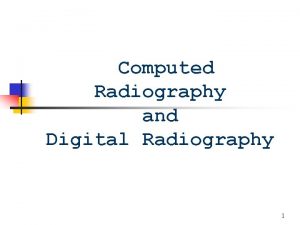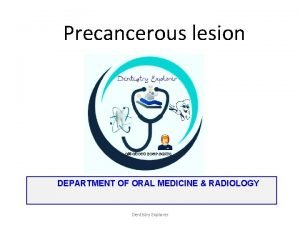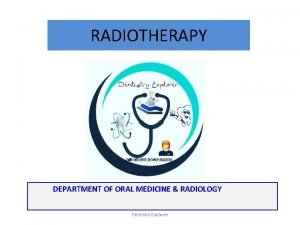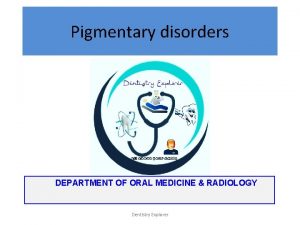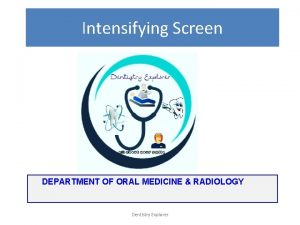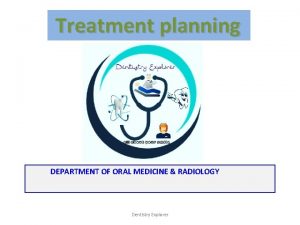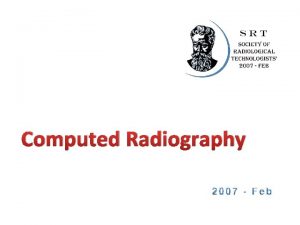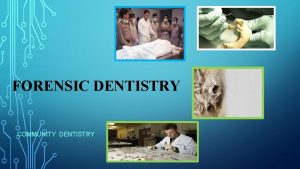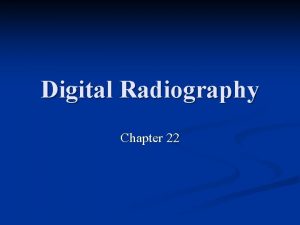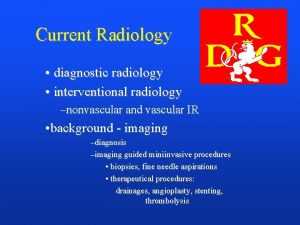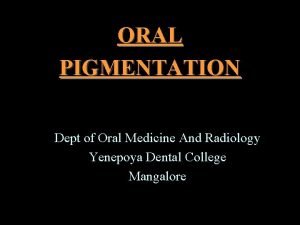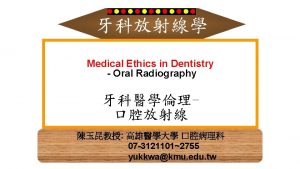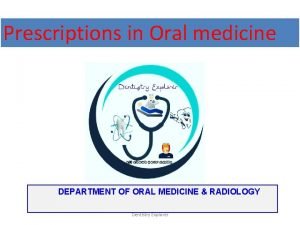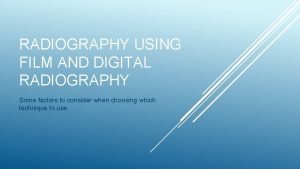DIGITAL RADIOGRAPHY DEPARTMENT OF ORAL MEDICINE RADIOLOGY Dentistry


















































- Slides: 50

DIGITAL RADIOGRAPHY DEPARTMENT OF ORAL MEDICINE & RADIOLOGY Dentistry Explorer

Fundamental Principles of Digital Radiography • Digital radiography refers to a method of capturing a radiographic image using a sensor, breaking it into an electronic pieces, and presenting and storing the image using a computer. • In stead of having an analog radiographic image on a film, in digital imaging the sensor is used to receive the analog information and through analog-to-digital converter (ADC) to convert it to a digital image that is an array of picture elements called pixels, with discrete gray values for each one. Dentistry Explorer

• Special software is used to store and manipulate the digital image in the computer. The image is displayed within seconds or minutes on the computer screen in front of the clinician and the patient/client. Dentistry Explorer

Dentistry Explorer

Techniques for exposing, processing and mounting digital radiographs • Currently, there are two types of digital radiography systems available: direct and indirect. • I. Direct Digital Imaging • II. Indirect digital imaging Dentistry Explorer

Indirect Digital Imaging: 1. Scanning of traditional radiographs. 2. Storage Phosphor Imaging or Photostimulable Phosphor Plate (PSP) Dentistry Explorer

Direct Digital imaging • In direct digital radiography the image accquired is sensitive to eletromagnetic energy either in the range of visible light or x-rays. • It does not require the use radiographic film. Dentistry Explorer

Advantages of RVG • One of the most valued advantages is Superior gray-scale resolution of 256 colours of gray in comparison with 16 to 25 shades of gray on a conventional film. This property allows facilitated contrast and density manipulation in order to enhance features or details of diagnostic importance, without additional exposure for the patient/client. • Colourization and enlargement of the images. • as well as manipulation with contrast, sharpness, image orientation and pseudocolour alteration. • Taking two images on the same area but in the different time and reversing their gray scale using the software will be useful for determination and analysis of patterns that may be characteristic of a particular disease or condition. Dentistry Explorer

• Reduced exposure to x-radiation is also a great advantage of digital radiography • Decreased processing time that digital radiography offers is of a great financial and professional value to any clinician. • Storage of radiographs into the small hard drive of the computer is a great space saver. • Digital images are easily transmitted to other offices. • Laptops, removable discs and CDs allow the systems to be easily moved. • After initial setup cost, everything else on a long run is financial saver: digital radiography eliminates the need for purchasing conventional films, costly processing equipment and solutions. • Darkroom is no longer needed. • Converting into the digital radiography will distinguish the dental office as environment friendly because no disposal hazards of processing chemicals, silver salts in film emulsion and lead foil sheets will exist. Dentistry Explorer

Extreme importance of RVG in Implantology • When accomplishing implant placement, using conventional radiography is a major inconvenience, as the entire aseptic procedure is disrupted and time is wasted while the clinician awaits the development of the films several times during the implant placement procedure. Dentistry Explorer

Advantage of RVG during the Endodontic treatment • The digital radiographic systems are efficient aids in an endodontic procedure. • a second image easily can be made from a slightly different angle without removing the sensor out of patient’s/client’s mouth. • eg, to make the second root canal better visible—with the sensor still in the same position, but with different angulation. Dentistry Explorer

Disadvantages of RVG • Initial cost for purchase and set up of the equipment as well as the cost for personnel’s training. • Sensors are the weak part of the system due to their relative rigidity and thickness that could produce uncomfort or pharyngeal reflex in patients/clients. • The viewable surface area is smaller than the total size of the sensor and sometimes sensors are not universal and interchangeable between different systems. Dentistry Explorer

• Digital sensors can’t withstand heat sterilization, therefore they require complete coverage with disposable plastic sleeves. • Digital radiographs have legal issues because of their potential for fraudulent use. Dentistry Explorer

Equipments Dentistry Explorer

Equipment The essential components of digital imaging include: • I. X-radiation source: most digital systems use conventional dental units as x-radiation source due to its compatibility. • • II. Intraoral Sensor: is a small detector that is placed intraorally and used to capture the radiographic image and send to the computer for future processing. Sensors are similar in dimensions like conventional films and may be either wired with 8 to 35 feet fiberoptic cable for transmittion of generated image to the computer or wireless. Intraoral sensor is composed of a silicone chip and a layer that surrounds it. Dentistry Explorer

• A layer above the sensor chip is the scintillator (material that emits light when particles traverse it), which converts x-ray energy into light and directs it towards the top layer of the chip that is more sensitive to light than x-rays. Top layer of the chip then releases electrons that form the image and send them onto the well in the lower portion of the chip. Dentistry Explorer

• The energy in each well is then read and digitized with an A/D (analog to digital) converter during the read-out process. Dentistry Explorer

Currently three types of sensor Technologies exist: • 1. Charge-coupled device (CCD) This is one of the most common image receptors in digital radiography. The CCD is sensitive to x-rays or light, it is a solidstate detector that contains a silicone chip with an electronic circuit embedded in. Dentistry Explorer

A CCD is made of an array of photodiodes (devices that conduct electricity when light or x-rays strike them) on top of a semiconductor. Dentistry Explorer

Charge-Coupled Device ( CCD ) Each element, called a ‘pixel’, is 20 -60 microns in size. (A human hair is about 60 microns in diameter!) Dentistry Explorer

Charge-Coupled Device ( CCD ) Display Storage Printer serial output register output amplifier Dentistry Explorer Computer hardware & software

Charge-Coupled Device ( CCD ) Dentistry Explorer

Charge-Coupled Device ( CCD ) Dentistry Explorer

Charge-Coupled Device ( CCD ) Advantage: ü High image quality at considerably less radiation dose as compared to film radiography. ü Image is dynamic and can be altered digitally. ü No processing required; therefore environment friendly. ü Image is available instantly. ü No processing errors. ü No loss of image over a period of time. ü Image duplication is very easy. ü Telemedicine. Dentistry Explorer

Charge-Coupled $ Device ( CCD ) Limitations: L Very high initial cost. L Sensor is bulkier compared to an x-ray film making it difficult to place in some parts of the mouth and in children. Dentistry Explorer

• 2. Complementary metal oxide semiconductor/active pixel sensor (CMOS/APS) The silicone chip for this type of sensor is less expensive to produce, offers greater durability and 25% greater resolution than charge-coupled device (CCD) sensor. Dentistry Explorer

3. Charge injection device (CID) This type of sensor doesn’t require computer for image processing. The CID sensor uses the same docking platform with intraoral camera, and within seconds directly produces digital image that can be seen on the monitor. Later on, this image can be saved in the computer or on a video disc recorder. Dentistry Explorer

Difference between wired and wireless sensors: • Wireless sensors are thicker than wired sensors. • The battery life is an important cost consideration when comparing systems. • The image quality is not affected by the wireless transmission. • Wireless systems are typically 1. 5 x as expensive as their wired counter part. • Another concern is losing or dropping of the sensor. Dentistry Explorer

Dentistry Explorer

• Photostimulable phosphor(PSP): -It is a digital detector. -Also known as storage phosphor -Ususally are of barium fluorohallide family. Dentistry Explorer

X-RAY PHOTONS EXCITEMENT OF ELECTRONS IN THE PHOSPHOR ELECTRONS TRAPPED WITHIN THE PHOSPHOR Subsequent stimulation of phosphor by the red light in the read out unit. Trapped electrons released with blue light emission i. e photo stimulated luminescence Blue light detected by photomultiplier tube Output of the tube digitized to form image Dentistry Explorer

III. Computer: • It is used to digitize process and store information received from the sensor in 0. 5 to 120 seconds and then present the image on the computer monitor. • The image may be stored permanently on the computers hard drive, printed on a hard copy or transmitted electronically to insurance companies or referring dental specialists. Dentistry Explorer

• X-ray photons that originate from conventional radiographic unit come in contact with the intraoral sensor and cause electrons to be released from the silicone chip and produce latent image. • Electrons travel to the computer unit where are converted into pixel arrangement that can be visually seen on the computer monitor. • A pixel is digital equivalent of a silver crystal used in conventional radiography. Dentistry Explorer

• For example, CCD sensor can produce 640 x 480 individual pixels in size. Each pixel is represented numerically in the computer by levels of colour of gray and varies from 0 to 255, which creates 256 shades of gray, referred to as a pixel’s gray-scale resolution. Dentistry Explorer

Step-by step procedure for the use of direct digital radiography system 1. Proper infection control of the intraoral sensor. 2. Placement of the sensor in the patient’s/client’s mouth on a conventional film holder. Paralleling technique is the preferred exposure method. 3. Radiation exposure of the sensor with conventional radiographic unit. 4. Digitalized conversion of the analog image into the computer, directly through fiberoptic cable or wireless sensor. 5. Display of the digital image on the computer monitor for diagnostic purposes of the current procedure. Dentistry Explorer

Infection control in Digital Radiography • Digital sensor is reusable device but can not stand the heat during the sterilization due to its constitution. Therefore, for infection purposes the sensor must be covered with a disposable barrier. • However if it becomes directly contaminated there is no way of sterilizing and the sensor should be discarded regardless of the expense. • Use of a barrier does not always protect from contamination. • To minimize the potential for device-associated infections, after removing the barrier, the device should be cleaned and disinfected with an EPA (Environment Protection Agency)-registered hospital disinfectant (intermediate-level) after each patient. Dentistry Explorer

Sensor that can be immersed in water Dentistry Explorer

Quality Assurance and Diagnostically Acceptable Radiographs in Digital Radiography: • The majority of the studies conclude that the diagnostic quality of digital images certainly is adequate. • Digital images perform at least as well as conventional radiographs and sometimes even better. • Two of the more common ways to test for its quality are spatial resolution and gray scale resolution. • Spatial resolution is the capacity to detect small details, and usually measured in line pair per mm (LP/mm). • On the other hand, the resolution expressed in gray scale is more than adequate. • Newer sensor systems capture the images at bit depths of 12 to 16, instead of the lower 8 bit (256 colours of gray) depth that was common in the past. • The higher bit depth will improve image quality under different exposure conditions. Dentistry Explorer

Dentistry Explorer

Legal issues in Digital Radiography : • Radiographic records also provide valuable information about whether treatment was justified. • Digital dental radiographs can be altered to show an apparent need for treatment that is not real or to show completed treatment that has not actually been performed. • The new altered image could be saved into the computer instead of the old one, submitted on new film or reprinted on duplicating film. • The altered images can be used to charge insurance companies for treatment that was not actually performed. Dentistry Explorer

A Case… Dentistry Explorer

Future of Digital Radiography in three dimensions • Three-dimensional reconstruction and rendering of radiographic image data has been introduced recently in the form of Cone Beam Computerized Tomography (CT) and Local CT. Both cone beam and local CT have imaging geometry comparable with that of conventional CT, but offer a higher resolution with a much lower radiation dose to the patient. The image appeared on the computer screen in three-dimensional. Dentistry Explorer

Summary: Digital Radiography is a powerful tool for dental practice • Digital dental radiography, in practice of dental professional is a powerful tool. • Some of the most important benefits this technology offers include patient education, time efficiency, reduced exposure to radiation (for the patient and practitioner), and environmentally friendly set up. • The initial appointment is usually the most critical time for patient assessment, not only from the data collection standpoint (in preparation for diagnosis), but also patient education. • Use of digital radiography saves a hygienist time, when compared with the traditional radiography, which can be utilized for building a report with the patient, educating patients on dental health, and proper assessment and diagnosis. Dentistry Explorer

MCQss… • CCD is made of: a) Photodiode b) Lanthanum Dentistry Explorer

• Which of the following is not a sensor? ? a) CCD b) CMOS c) CID d) PSP Dentistry Explorer

• Which of the following regarding RVG is incorrect? ? a) Requires radiograph b) No dark room delay c) Less radiation dose to patients d) Alteration of the image can be done Dentistry Explorer

• CCD is sensitive to: a) X-rays b) Light c) Both d) None Dentistry Explorer

• Resolution of CMOS is: a) 25% greater than that of CCD b) 25% less than that of CCD c) Equal to that of CCD d) 15% greater than that of CCD Dentistry Explorer

References: • • White and Pharoah Langlais and Langland Bailoor and Nagesh WWW. Google. Com Dentistry Explorer

THANK YOU!!! Dentistry Explorer
 Oral medicine and radiology day
Oral medicine and radiology day American academy of oral and maxillofacial radiology
American academy of oral and maxillofacial radiology Slouged
Slouged Faculty of medicine dentistry and health sciences
Faculty of medicine dentistry and health sciences Dentistry & oral sciences source
Dentistry & oral sciences source Oral medicine
Oral medicine Department of medicine solna
Department of medicine solna Department of medicine mcgill
Department of medicine mcgill Focal trough in panoramic radiography
Focal trough in panoramic radiography Off center grid error
Off center grid error Emulsion peel in radiography
Emulsion peel in radiography Latent image formation in radiography
Latent image formation in radiography Radiographic errors in dentistry ppt
Radiographic errors in dentistry ppt Filmless radiography
Filmless radiography Sid and oid in radiography
Sid and oid in radiography Cassette construction
Cassette construction Destructive pathology
Destructive pathology Radiography safety precautions
Radiography safety precautions Measurement equipment shelves, darkroom
Measurement equipment shelves, darkroom Radiography cordon off distance formula
Radiography cordon off distance formula Optical density in radiography
Optical density in radiography Linear focused grid
Linear focused grid Formation of latent image
Formation of latent image Soot and whitewash radiography
Soot and whitewash radiography Industrial radiography accidents
Industrial radiography accidents Radiography
Radiography Upper oblique occlusal radiograph
Upper oblique occlusal radiograph Industrial radiography accidents
Industrial radiography accidents Rni radiography
Rni radiography Ombl radiography
Ombl radiography Industrial radiography training
Industrial radiography training Limitations of radiography
Limitations of radiography Buccal object rule
Buccal object rule Lateral jaw radiography
Lateral jaw radiography What is computed radiography
What is computed radiography Mask mode radiography
Mask mode radiography Enhancement using arithmetic/logic operations
Enhancement using arithmetic/logic operations Chapter 3 image
Chapter 3 image Uretorocele
Uretorocele Recumbent position
Recumbent position Middlesex radiology
Middlesex radiology Pharmacology and venipuncture in radiology pdf
Pharmacology and venipuncture in radiology pdf Uk competition ratio
Uk competition ratio Bryant triangle normal range
Bryant triangle normal range Tcl bookstore
Tcl bookstore Statdx elsevier
Statdx elsevier Scottish radiology transformation programme
Scottish radiology transformation programme Sami haims
Sami haims Community college of denver radiology
Community college of denver radiology Pa dental radiology ce requirements
Pa dental radiology ce requirements Compton scatter radiology
Compton scatter radiology


